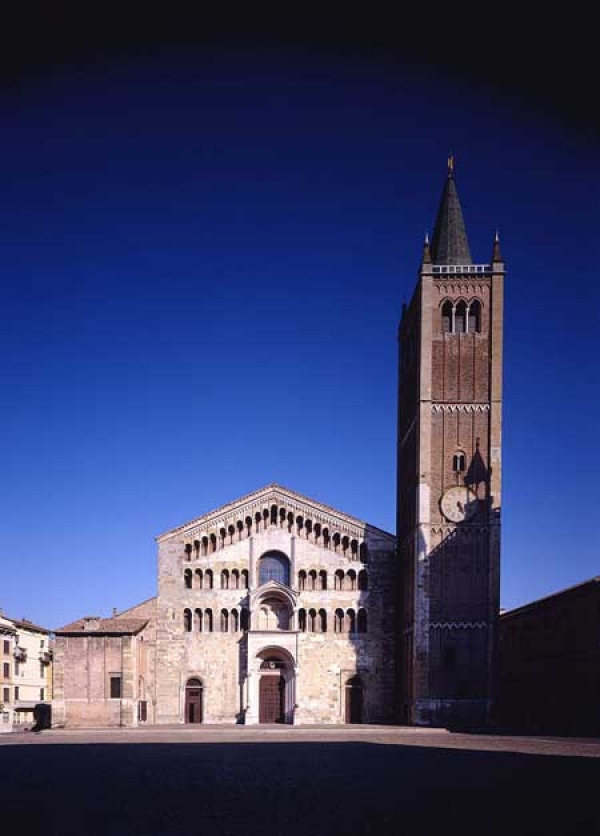HISTORY
The Cathedral of Parma, together with the nearby baptistery, is one of the most important monument of Romanesque art in the Po valley. The structure of the cathedral is quite complex, reflecting the many architectural changes it underwent over the centuries. Great artists worked on it, many important Italian sculptors well known in the Romanesque period such as Benedetto Antelami (1150-1230 AC). During the sixteenth century, many painters went on with the embellishment of the building: beautiful frescoes, among which the famous “Ascension of the Virgin” made by Correggio between 1526 and 1530, covered the walls and ceilings of the church. The building is a mixture of two Romanesque styles: the "Lombard" style that we can also see in the cathedrals of Piacenza and Cremona, both architectonically very similar to that of Parma, and the “Germanic" style reinterpreted here according to the local manners. The consecration to St. Mary of the Assumption (Santa Maria Assunta) dated to 1106 under Pope Pascal II. A document dated 884 attests the existence of a primitive church "infra civitatem parmensem”.
The construction of the actual cathedral began under Bishop Cadalo (1046 - 1071), after a fire that in 1058 destroyed the previous church. The Chronicles of Parma (Chronicon Parmense) tell about a terrible earthquake in 1117 that caused many damages (“Ecclesiae Sanctae Mariae magna pars dirupta est"). However, works continued and ended in 1178. On that year, Antelami worked on a pulpit of which remain today only the element representing the Deposition of Christ.
ART-HISTORICAL NOTES
EXTERNAL
Its gabled façade is the result of a delicate balance between structure and decoration, which integrate each other according to the padano-Lombard tradition, as we can also see on the facade of San Michele in Pavia. Its stone structure is composed of three levels. The first includes three portals of which the central has a decorated prothyron with column-bearing lions executed in 1281 by Giambono Bissone. The second part is composed of two orders of three mullioned loggias with Verona marble columns. On the bottom edge of the arc of the prothyron is carved a relief with the cycle of the months, which dates back to the twelfth century. The continuous frieze of the portal represents hunting scenes and monstrous animals. The decoration of the façade shows the same overlapping loggias of the apses, generating strong chiaroscuro contrasts. The presbytery outside is characterized by plastic effects thanks to the succession of square and semi-cylindrical volumes, decorated with pilasters and blind arcades ending with loggias. The bell tower is square with thin vertical pilasters, according to the typology of the Lombard Romanesque style. The elegant three-mullioned window and the crowning spire, dating from the end of XIII century, are clearly inspired by Gothic.
INSIDE
The plan of the Parma Cathedral is a Latin cross with three naves and a transept that ends with semicircular niches. The clustered and composite columns give a vivid impression of verticality. They are decorated with capitals and half columns upon which lean high ribbed vaults. The interior is both majestic and imposing. The woman’s galleries consist of four mullioned windows with capitals decorated with herbal motifs and symbolic themes as the Woman of the Apocalypse (Signora Dell'Apocalisse). The rings of the arches lean on corbels carved in the shape of animal or human head. The sleek appearance of the structure is enhanced by the raising of the presbytery finished with the tiburio in which was built the famous dome in the sixteenth century. The vast crypt under the presbytery has cross vaults on carved capitals with phytomorphic motif from XII century. The capitals of the nave are probably later. The sculptures are not homogeneous and probably are carried out by several artists. The Master of the Month (Il Maestro dei Mesi), however, seems to have been particularly active: he works also on the development of sculptures inside of the building and in particular on the cycle of months in the prothyron. The most important sculptor was, however, Benedetto Antelami. The bishop’s throne is monumental: both telamons, the representations of Saint Georges killing the Dragon and the Conversion of St. Paul, are harmoniously integrated into the cubic structure of the throne. Antelami comes off in the Deposition of Christ to the realism of Wiligelmo (who decorated the Cathedral of Modena), reviving the content and getting elegant and balanced sculptures that show his adherence to the models beyond the Alps, probably due to a stay in Provence. An herbal fascia frames the relief in which there are inscriptions with the names of the characters in the scene. At the top on the right, there is the sculptor's signature. The figures are firmly anchored to the bottom frame and the draperies are well-defined creating strong contrasts of light and shadow. The Cross of Christ harmoniously divides the scene into two equal parts: to the right the Christian world and to the left to the pagan. This division is emphasized by the representation of the sun and moon symbolizing good and evil respectively. It reflects a gothic taste, also visible in the Parma Baptistery in which Antelami worked around 1200.






